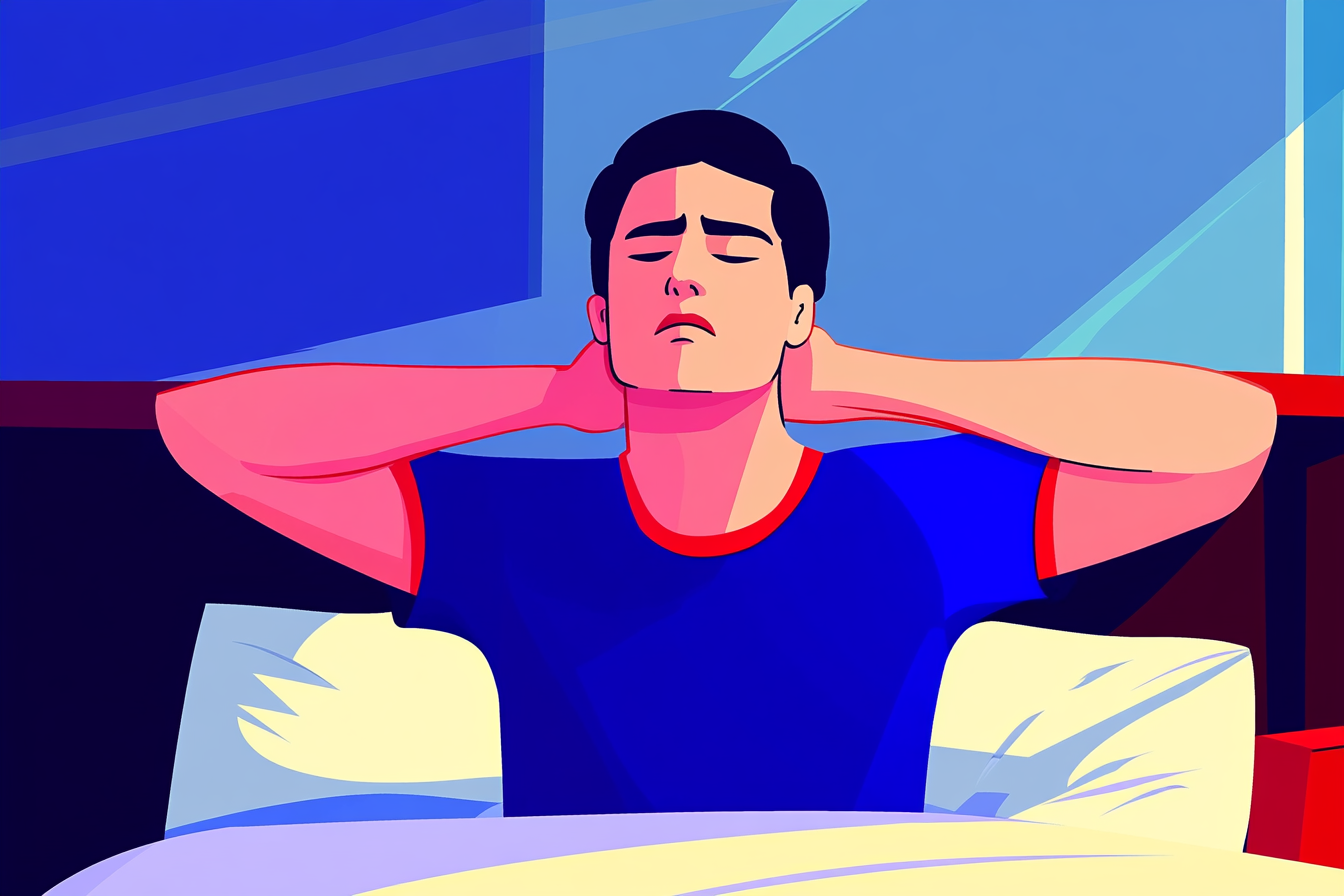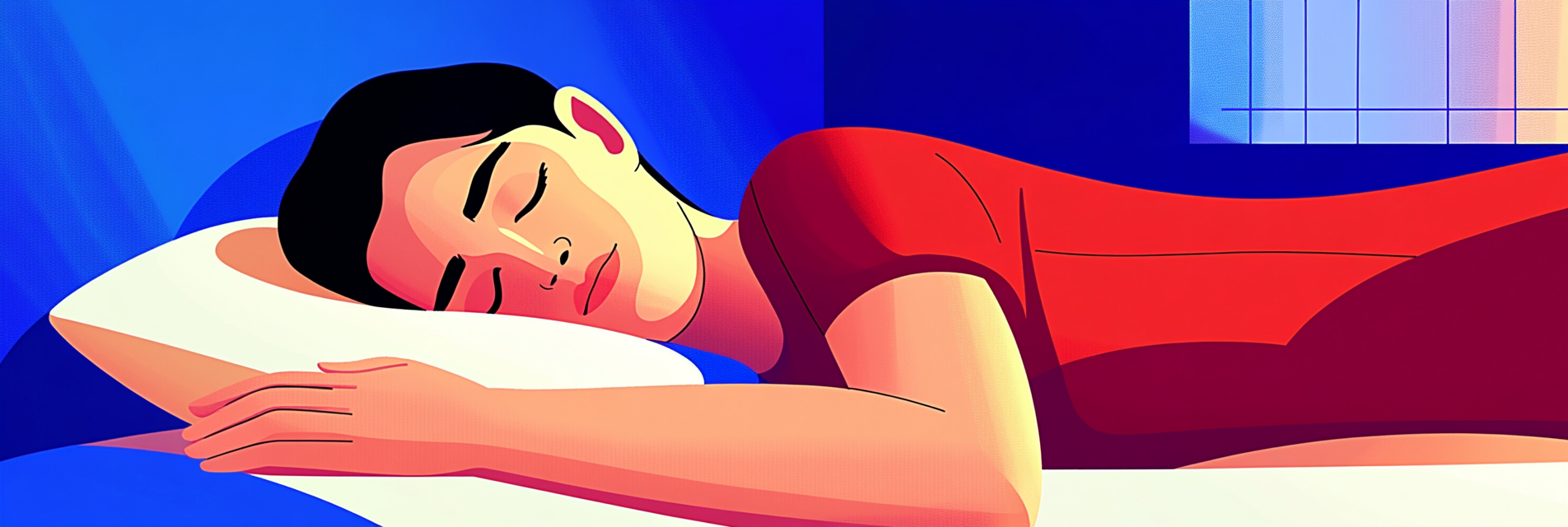Best Sleeping Positions For Neck Pain: How to Wake Up Pain-Free

Ever wonder why we label something unpleasant and irritating as “a pain in the neck?” It’s because living with just a couple of days of neck pain can quickly dampen your mood and make life much more of a challenge. It can also make getting a good night’s rest very hard.
Neck pain can be acute, caused by muscle, tendon or ligament strain. This kind of pain tends to resolve on its own in a week or two. It can also be chronic, in which case it can last for weeks or even months.
Finally, it can also be caused by your sleeping habits. Your sleeping position, choice of pillow or your unusual nightly contortionist habits could be the reason you wake up with a stiff and painful neck.
A study published in the Mayo Clinic Proceedings has found that over 30% of people will suffer from some form of neck pain in any given year.(1) If this happens to be you, here are the best sleeping positions for neck pain that can help.
Key Takeaways
-
The best sleeping positions to relieve neck pain are sleeping on your side and sleeping on your back. Sleeping in a reclined position can also be helpful.
-
The worst sleep position for neck pain is sleeping on your stomach.
-
Choosing a pillow and mattress that suit your sleep style can help ease pain in the neck.
-
Good sleep hygiene habits and some light pre-bedtime stretching are also recommended.
Table of Contents
What Is the Best Sleeping Position for Neck Pain?

There is no single best sleeping position to reduce neck pain. However, sleeping on your side and sleeping on your back are considered the best choices.
A bit of trial and error might be required to figure out what works best for your particular type of neck pain.
Sleeping on Your Side
Sleeping on your side is one of the best sleeping positions if your neck hurts. Since there are so many side sleeping positions, you are practically guaranteed to find one you are comfortable in.
The key is to align your head and neck with the rest of your body, keeping them in a neutral position, supporting the natural curve of your spine. This will prevent too much weight from being placed on your neck, causing discomfort and pain. To do this, you will need a pillow that is just right: neither too soft and fluffy, nor too firm or flat.
Look for a supportive pillow or stack of pillows that keeps your neck straight and does not let it fall too much, yet also doesn’t raise it too high.
Any kind of pillow can work. Memory foam and latex pillows usually provide more support than a feather pillow, though. A special cervical pillow can be a great choice, too. Some people also prefer a horseshoe-shaped pillow.
You can also modify your current pillow by rolling up a small towel and placing it underneath your neck for additional support. It should fill any space that is currently keeping it out of alignment.
Don’t forget to switch sleeping sides during the night to prevent arm or shoulder discomfort.
Sleeping on Your Back
Sleeping on your back, also known as the supine sleeping position, is your next best choice. It can be a better option if sleeping on your side is causing pain in your shoulders, for example.
Your aim is still to keep your head and neck in a neutral position and your spine aligned. Pillow choice is again very important, as you don’t want your head to be raised too high. You can still use the rolled towel to provide additional support if needed.
Placing a pillow under your knees can also help maintain the natural curve of your spine, which can also ease lower back pain.
Keep your hands by the side of your body or place them on your chest to ensure proper spinal alignment.
Sleeping in a Reclined Position
You can also try sleeping in the reclined position if you have an adjustable bed. Place a wedge pillow under your upper body to elevate it if you’re sleeping in a regular bed. This will keep your cervical spine in a more comfortable position.
This position works well for those who suffer from cervical radiculopathy, i.e., a pinched nerve in the neck.
What Is The Worst Sleeping Position For Neck Pain?
Stomach sleeping, also called the prone sleeping position, has been found to be the worst sleeping position for neck pain, according to The Internet Journal of Allied Health Sciences and Practice.(2)
When you sleep on your belly, your head will be turned to one side. This position is anything but neutral. If you hold it for a long time, it will cause neck stiffness and pain. It can also place a lot of weight on the neck, which will lead to even more strain and soreness. And we already know that sleeping wrong is bad not only for your spine health, but for your overall well-being too.
Avoid sleeping in this position if you can. If not, use a flatter pillow or forego one altogether. You can also place one under your hips to improve spinal alignment.
Why Is Sleeping With Neck Pain a Challenge?
Getting a good night’s sleep can be challenging with any type of pain. Neck pain, in particular, can be aggravating because it comes with other unpleasant symptoms. Numbness, tingling and shoulder pain can all occur.
All of this makes it difficult to find a comfortable sleeping position. And without quality sleep, you will feel more stressed and cranky. This can create a vicious cycle, where your lack of sleep additionally exacerbates your symptoms and prolongs healing time.
Why Do I Wake Up With Neck Pain?

There are several reasons why you may be waking up with a stiff neck or neck pain. They include:
-
Muscle strain: Sleeping with your neck at an awkward angle can strain your neck muscles. This is especially common if you sleep on your stomach or if you sleep on your back with an inadequately supportive pillow.
-
Wrong choice of pillow: Speaking of pillows, if you are using one that’s too high or too low, it may not be able to keep your neck and spine straight while you sleep, potentially resulting in poor sleep quality.
-
Poor daytime posture: Prolonged periods of slouching in front of a screen or extending your neck can exacerbate the strain during sleep.
-
Stress: Stress and anxiety can cause muscle tension during the day and at night. This tension can cause neck pain upon waking.
-
Previous neck injuries: If you have suffered from a neck injury in the past, sleeping in the wrong position or with the wrong pillow can make it worse. One such common injury is whiplash, either from a car accident or from playing sports.
-
Aging: As we get older, we can develop musculoskeletal and skin diseases that can cause neck pain. These include herniated discs, osteoarthritis and spinal stenosis.
-
Temporomandibular Joint Dysfunction (TMJ): While the main symptom of TMJ is a clenched jaw and nightly teeth grinding, sufferers also report waking up with neck pain and stiffness.
Tips For Sleeping With (and Preventing) Neck Pain
Whether you are suffering from chronic or acute neck pain, here is what you can do to sleep better. These tips should also prevent waking up with neck pain.
Start by evaluating your mattress. How old is it? If you’ve had it for over 8 years, it might be time for a new one. Consider a medium-firm mattress that will provide adequate support for both your neck and back.
Apply the same level of scrutiny to your pillow(s). You should swap them out every year or two, as this is when they start to lose their firmness and shape. The best pillows for neck pain provide adequate levels of support. Memory foam pillows tend to be a popular choice, but you can also look into other materials if they suit you more. Just make sure they can keep your neck properly aligned in your preferred sleeping position(s).
Performing light neck stretches a couple of times a day can help with neck pain. Go through the whole range of motion gently: side-to-side, up-and-down, circles in both directions. Stretching your entire upper body before bed can also be a relaxing way to settle in for the night. If you are in severe pain, a healthcare provider may recommend physical therapy.
Apply a hot or cold compress. Both heat and cold can help with neck pain. An ice pack can ease pain in the first 48 to 72 hours after an injury. Just remember not to put ice directly on your skin! A heating pad can help relieve tension, soothe sore muscles and provide temporary relief.
Be mindful of your posture during the day. If you spend a lot of time sitting at a desk, make sure the chair provides adequate support for your spine and neck. Align it properly with your keyboard and mouse, so that you aren’t unnecessarily and uncomfortably hunched. When looking at your phone, be mindful of your neck and take frequent breaks to stretch.
If your neck pain is keeping you awake, you may want to take over-the-counter pain relievers. Make sure to talk to your healthcare provider before taking any medicine you haven’t used before, or if you suffer from a chronic illness. Note that this shouldn’t be a long-term solution, only to provide temporary pain relief.
Good sleep hygiene goes a long way, especially if you suffer from occasional neck soreness. Avoiding screens before bedtime, having a relaxing evening routine and going to bed at the same time every night will help you fall asleep more easily.
Healthy lifestyle choices will also boost your overall health and well-being. Regular exercise and a balanced diet can help reduce stress and anxiety, which will also benefit your neck.
If your neck pain does not go away on its own after a week or so, or worsens to the point that you can’t function normally, make sure to see your doctor. They may recommend you see a physical therapist to get some pain relief.
Getting restful sleep when your neck hurts can be particularly difficult. You can easily become stressed and anxious, which will further disrupt your rest.
Finding the right sleeping position can help alleviate discomfort and improve sleep quality. Try side sleeping and back sleeping, and make sure you choose a pillow with just the right amount of support.
What is your preferred sleeping position when the neck pain flares up? Tell us in the comments!
Conclusion: Finding Your Perfect Sleeping Position
Sources:
(1) “Epidemiology, Diagnosis, and Treatment of Neck Pain.” Mayo Clinic Proceedings, www.mayoclinicproceedings.org/article/S0025-6196(14)00833-7/fulltext. Accessed 18 June 2025.
(2) “Sleep Position, Age, Gender, Sleep Quality and Waking Cervico-Thoracic Symptoms.” The Internet Journal of Allied Health Sciences and Practice, nsuworks.nova.edu/ijahsp/vol5/iss1/6/. Accessed 18 June 2025.
Disclaimer: The information contained in this website or provided through our blog, e-mails, or programs is for informational purposes only. It is not intended to be a substitute for medical advice, diagnosis or treatment that can be provided by your healthcare professionals.












































